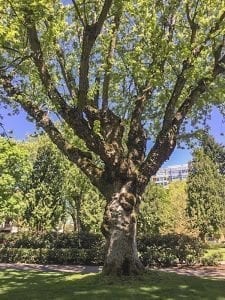VANCOUVER — An aging, silver maple tree with significant decay will be removed from Esther Short Park this month.

For several years, the city of Vancouver’s Urban Forestry team has been monitoring the structure of a silver maple, north of the park’s pavilion. The latest finding: Major internal decay throughout the tree’s trunk and branches has reached a point where the tree is more of a liability than an asset to the park and the public.
Most of the park’s mature, majestic trees date back to the early 1900s. Many of those are deciduous species that typically don’t have long lives. That includes the silver maple, a species known for its quick growth. Unfortunately, that fast growth rate also tends to create weak wood which is not able to prevent or contain the spread of internal decay or disease.
Compounding this issue, during the mid-1900s, this silver maple was also subjected to a practice known as topping. Topping, the indiscriminate removal of a tree’s crown, was common and poorly understood until about the 1970s, when advancements in the science of arboriculture showed that topping actually damages trees and creates unsafe conditions. Topping has long since been removed from national tree care standards. Vancouver’s Urban Forestry Program actively works with tree care professionals and neighbors to guard against the harmful practice of topping.
“In recent years, restorative pruning by selectively reducing weight in the crown has helped reduce branch failure in park trees,” Urban Forester Charles Ray said. “Still, it was just a matter of time before the amount of decay in this tree would become unmanageable due to the species and its past history.”
Ray said the city has implemented a tree succession plan to ensure future generations will be able to enjoy the flourishing green canopy over Esther Short Park. New, long-lived deciduous trees — an elm, ginkgo, and oak tree — have already been planted in the area of the silver maple.
Vancouver’s urban forest is an integral part of the city’s physical infrastructure, providing a strong sense of community, a pleasant environment, improved water and air quality, enhanced wildlife habitat, and many other benefits. Proper planting of the right tree in the right place, along with proper pruning and maintenance, are the best defenses against tree damage.
Learn more about trees, tree permits, and tree care at www.cityofvancouver.us/urbanforestry.
Information provided by City of Vancouver.




